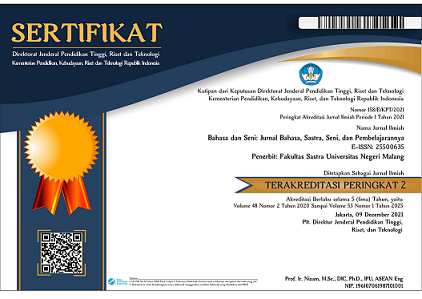THE COMMENTERS’ READING POSITIONS IN AN ONLINE NEWS ARTICLE’S COMMENT COLUMN: A SPEECH ACT ANALYSIS ON MEDIA DISCOURSE
Abstract
THE COMMENTERS’ READING POSITIONS IN AN ONLINE NEWS ARTICLE’S COMMENT COLUMN: A SPEECH ACT ANALYSIS ON MEDIA DISCOURSE
Abstract: This study investigated the commenters’ reading positions in an online news article’s comment column. The first theory that coined the reading position is Stuart Hall. Based on Hall's theory, there are three reading positions for the readers in interpreting a text. First is the dominant or hegemonic reading position that means the readers who fully share the text, receive, and then reproduce it. Second is the negotiated reading position; it means the readers who do not fully share the text yet generally receive it. In this position, they sometimes refuse and modify the text by reflecting their positions, experiences, interests, or even contradictions. The third is the oppositional or counter-hegemonic reading position; it means the readers whose social situation places them in direct opposition relationships with the text. They understand the text but do not share it and reject it. In this study, the researcher used the speech act theory to describe and find out the commenters’ reading positions in the selected data. There are 42 comments have written on the comment column of an online news article entitled ‘Singles in Indonesia are in trouble and under pressure: study’ that was shared on Facebook. The researcher used the qualitative descriptive method for analyzing the data. The results are 14 commenters were identified in the hegemonic reading position, 17 commenters in the negotiated reading position, and 11 commenters in the oppositional reading position.
Keywords: News commenters, Media discourse, Reading positions, Single women discourse, Speech acts.
POSISI MEMBACA PENULIS KOMENTAR PADA KOLOM KOMENTAR BERITA ARTIKEL ONLINE: ANALISIS TINDAK TUTUR TENTANG DISKURSUS MEDIA
Abstrak: Studi ini meneliti posisi membaca penulis komentar dalam kolom komentar sebuah artikel berita online. Teori posisi membaca pertama kali diungkapkan oleh Stuart Hall. Terdapat tiga posisi membaca bagi para pembaca dalam menafsirkan atau menginterpretasikan sebuah teks. Pertama adalah posisi membaca yang dominan atau hegemonik yang artinya para pembaca yang sepenuhnya membagikan teks, menerima serta mereproduksi teks tersebut. Kedua adalah posisi membaca yang dinegosiasi yang artinya para pembaca yang tidak sepenuhnya membagikan teks tetapi umumnya menerima teks tersebut. Pada posisi ini, mereka terkadang menolak dan memodifikasi teks dengan cara merefleksikan posisi, pengalaman, minat atau bahkan kontradiksi mereka. Ketiga adalah posisi membaca oposisional atau kontra-hegemonis yang berarti para pembaca yang situasi sosialnya menempatkan mereka dalam hubungan oposisi langsung dengan text. Mereka sebenarnya memahami teks tersebut akan tetapi tidak berbagi dan menolak teks tersebut. Dalam studi ini, kami menggunakan teori tindak tutur untuk menggambarkan dan mengetahui posisi pembaca penulis komentar dalam data yang dipilih. Data penelitian ini adalah 42 komentar yang ditulis pada kolom komentar artikel berita online yang berjudul ‘singles in Indonesia are in trouble and under pressure: study’ yang dibagikan di Facebook. Dalam menganalisis data tersebut, kami menggunakan metode deskriptif kualitatif. Hasilnya adalah 14 penulis komentar teridentifikasi ada dalam posisi membaca hegemonis, 17 penulis komentar dalam posisi membaca yang dinegosiasi, dan 11 penulis komentar dalam posisi membaca oposisional.
Kata kunci: Penulis komentar berita, Wacana media, Posisi membaca, Wacana perempuan lajang, Tindak tutur.
Full Text:
PDFReferences
Austin, J. (1962). How to Do Things with Words. Oxford: Clarendon Press.
Badarneh, M. A., & Migdadi, F. (2018). Acts of positioning in online reader comments on Jordanian news websites. Language & Communication, 93-106.
Bhattacherjee, P. A. (2012). Social Science Research: Principles, Methods, and Practices. Florida: Creative Commons Attribution.
Chandler, D. (2007). Semiotics The Basic: Second Edition. New York: Routledge.
Cruse, A. (2000). Meaning in Language. New York: Routledge.
Cutting, J. (2002). Pragmatics and Discourse. London and New York: Routledge.
Danesi, M. (2002). Understanding Media Semiotics. New York: Arnold.
Grundy, P. (2000). Doing Pragmatics. New York: Arnold.
Guiraud, N., Longin, D., Lorini, E., Pesty, S., & Riviere, J. (2011). The face of emotions: a logical formalization of expressive speech acts. The 10th International Conference on Autonomous Agents and Multiagent Systems (AAMAS 2011) (pp. 1031-1038). Taipei, Taiwan: International Foundation for Autonomous Agents and Multiagent System.
Hall, S. (1997). Representation: Cultural Representation and Signifying Practices. London, Thousand Oaks, New Delhi: SAGE Publications.
Heni Haryani, Heriyanto, Eva Tuckyta Sari Sujatna. (2014). Speech Functions in Television Channels Slogan: A Comparison of Subscribe and Unsubscribe Television Channels. International Journal of Language Learning and Applied Linguistics World (IJLLALW), 447-461.
Paltridge, B. (2012). Discourse Analysis. London, New Delhi, New York, Sydney: Bloombury Academic.
Riley, P. (2008). Languages, Culture and Identity. London and New York: Continuum.
Ronan, P. (2015). Categorizing expressive speech acts in the pragmatically annotated SPICE Ireland corpus. ICAME Journal, 25-45.
Schiffrin, D. (1994). Approaches to Discourse. Massachusetts: Blackwell Publishers.
Searle, J. (1969). Speech Acts: An Essay in the Philosophy of Language. New York: Cambridge University Press.
Searle, J. (1979). Expression and Meaning: Studies in the Theory of Speech Acts. New York: Cambridge University Press.
Stuart Hall, Dorothy Hobson, Andrew Lowe, Paul Willis. (2005). Culture, Media, Language. London and New York: Taylor & Francis e-Library.
Yule, G. (1996). Pragmatics. New York: Oxford University Press.
DOI: http://dx.doi.org/10.17977/um015v48i12020p31
Refbacks
- There are currently no refbacks.

This work is licensed under a Creative Commons Attribution 4.0 International License.

Dear Sir/Madam
We appreciate your continued confidence and trust in Bahasa dan Seni: Jurnal Bahasa, Sastra, Seni, dan Pengajarannya (JBS). In order to enhance the service, readability, and quality of JBS publications, we will be transitioning to a new website, https://citeus.um.ac.id/jbs, in collaboration with Digital Commons (Elsevier) starting in July 2024.
Sincerely
Yusuf Hanafi
(Editor in chief)















2.png)